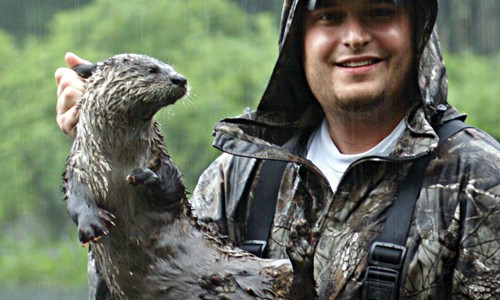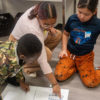On the Hunt to Help the River Otter

Posted by: admin on August 28, 2009, No Comments
Canoeing the waterways of the Poconos, Jim Kauffman and Sam Loffredo search for signs of river otters, hoping to capture eight of these playful and energetic animals. Radio transmitters will be implanted in the otters. Radio telemetry is an important tool in wildlife research. It is the best available method for estimating home range, and determining habitat selection of wild, free-ranging animals.
“There’s not a lot of information about the otters in Pennsylvania and New Jersey, and they’re a species of special concern,” says Kauffman, an ESU graduate student in biological sciences whose thesis is a comprehensive study of the semi-aquatic mammals known as Lontra canadensis.
Under the guidance of Dr. Jane E. Huffman, distinguished professor of biological sciences, Kauffman is studying the range, diet, and genetic structure of otters, as well as intestinal parasites they may harbor.
Assisting him is Sam Loffredo, an ESU undergraduate student majoring in exercise physiology. The project is funded by the Pennsylvania Trappers Association, a group of sportsmen involved in wildlife research, management and conservation.
Otters were reintroduced into Pennsylvania waterways in 1982. To locate otters Jim and Sam look for otter sign which include dens and latrine sites. An otter roll is another sign you might look for when tracking otters. When otters come out of the water, they need to dry themselves off. They will do this either with a roll of grass that is used much like a towel, or they will roll around on their backs, flattening out a large area of grass. Both of these signs can be seen very near the water and often near a latrine site.
Once otters are captured, a veterinarian implants a transmitter in them. Using telemetry equipment, Kauffman will track each otter, monitoring its movements and establishing the extent of its home range.
“Jim has a built-in curiosity to discover how things work,” says Huffman. “This curiosity has led him to explore what animals need to survive and be healthy.”
Otters primarily feed on fish supplementing their diet with amphibians, crayfish, mollusks and other invertebrates. Kauffman will be looking at the dietary preferences of the local otters
“The development and application of genetic markers will also enable us to establish a genetic profile for the Pennsylvania and New Jersey otters, and possibly determine a population estimate,” Huffman says.
Kauffman, who earned his bachelor’s degree in wildlife and fisheries science from Penn State University, came to East Stroudsburg for his post-graduate work because of ESU’s biology program.
“They have a great reputation, especially in the field of wildlife research,” he says. The state’s otter reintroduction program was initiated by Dr. Larry Rymon and graduate student Tom Serfass from ESU. Dr. Serfass is now a biology professor at Frostburg State University in Maryland. Kauffman, with permits from the Pennsylvania Game Commission, has access to many wetlands and waterways for his research.
“There are a lot of opportunities for research in the area, particularly within the Delaware Water Gap National Recreation Area,” he says.
Kauffman enjoys the study of ecology, Huffman notes, specifically the interactions between individual species and their environments. His aptitude for problem-solving and developing new techniques is especially useful for this important study.
“The human impact on wildlife populations and habitat continues to increase,” Huffman says. “Conservation and management policies are more important than ever, and field research is vital in order to provide the information and knowledge needed for effective conservation.”
Search
Recent Posts

Provost’s Colloquium Series Presents “A Visitor Sentiment Analysis of PA Wineries: A Big Data Approach and A Guided Wine Tasting”
April 16, 2024 - Read more



